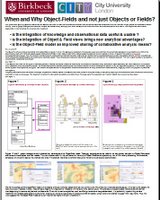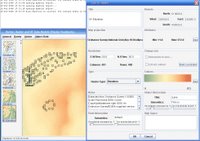
This is the poster I presented at GIScience 2006. The poster forms part of a proposal to consider how the Object-Field model, a model that is considered to combine both the discrete-object and continuous-field views, has some unique qualities for collaborative decision making. It aims to prompt conceptual and theoretical thoughts and discussions by identifying when to use the Object-Field model and not the conventional object and field models . The insights and comments addressed the following kinds of questions :
1) Is the integration of knowledge and observational data useful & usable ?
2) Is the integration of Object & Field views brings new analytical advantages?
3) Is the Object-Field model an improved sharing of collaborative analysis means?
An answer?
The Object-Field model enables visualization and representation of objects in a field. This approach (visualization of field objects) could work better than the conventional approaches in a collaborative environment by presenting the users with multimedia objects, objects that record information in text, image or other forms, related to specific locations or a set of locations in a field. An object in this context is a modeller’s conceptualization/knowledge. Thus, the users are not presented with just observational data but this data is augmented by visualized users' conceptualizations/knowledge of geographic domains, and their understanding using embedded metadata expressed as semantic and uncertainty objects. These embedded semantics and uncertainties propose a new dimension in the metadata discussion. This is the explicit recording of collaborative understanding, interpretation and criticism.
In the Object-Field model, the four types of relationships between locations and objects enables the conventional one location-one object and many locations-one object relationship but it also enables the one locations-many objects and many locations-many objects. This mathematically-based relations between objects and locations enables the user to rearrange the objects in a way that supports comparisons. It also enables a object-based approach when operations are applied. Thus different conceptualizations and interpretations between collaborators can be easily visualized and cross-checked by reapplying them to new purposes or procedures
Integrating observational data and derived knowledge (expressed as metadata objects in the Object-Field model) enable us to improve sharing of analysis by designing a user interface that uses the same set of tools for the exploration of data and knowledge. This integration is important in cross-cultural collaborative environments as it manages semantic inaccuracies and making metadata not only useful but also usable.




